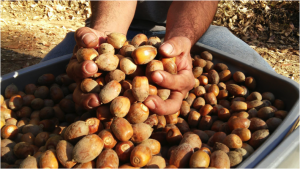A SUMMARY OF AMAH MUTSUN LAND TRUST PROJECTS
By AMLT Research Associates Rob Cuthrell, Rick Flores, and Sara French and AMLT Project Assistant Jay Scherf, April 2016
Introduction
From archaeological and fire research to educational gardens, the Amah Mutsun Land Trust is bringing indigenous stewardship back to the lands of the Amah Mutsun. Through a range of projects that span the Tribe’s ancestral territories, we have forged valued partnerships with conservation organizations, land managers, and research institutions. The diversity of our work testifies to the breadth and importance of indigenous ecological knowledge. Learn more about our current projects below:

Park staff and tribal members consult on the management of deergrass, pictured in foreground.
Photo courtesy Paul Johnson
Pinnacles National Park
The Amah Mutsun Tribal Band has worked in collaboration with Pinnacles National Park since 2006. The park and the tribe co-developed an experimental project to restore basket weaving plants using indigenous stewardship practices; and in 2011 project partners implemented the first burn for cultural purposes since the mission period in Amah Mutsun territory. Pinnacles National Park and the Amah Mutsun Tribal Band have a Memorandum of Understanding that recognizes the importance of cooperating with the Amah Mutsun on matters of cultural resource stewardship within park boundaries. The Amah Mutsun consult with Pinnacles on interpretation of California Indian history and culture, the significance of the endangered California condor, and the management and restoration of culturally significant species.

Tribal Stewards clearing coastal prairie at Quiroste Valley Cultural Preserve.
Photo courtesy Rob Cuthrell
Quiroste Valley Cultural Preserve
Quiroste Valley Cultural Preserve is a 225-acre portion of Año Nuevo State Park where the California Department of Parks and Recreation is working collaboratively with AMLT to protect and steward cultural and natural resources. The preserve was created in 2008 due to the presence of significant archaeological, historical, and ethnobiological resources in the valley. Since 2007, AMLT has been working with a multidisciplinary team of scientists to research the relationships between Native people and the Quiroste Valley landscape over the long term. The research suggests that Native people maintained open coastal prairies in this area through frequent landscape burning. Today, most of the landscape has transitioned to shrublands and conifer forest due to lack of active management. Beginning in 2015, AMLT has been working to preserve and expand coastal prairies, as well as to remove selected invasive exotic plants like poison hemlock.

Tribal Steward Abran Lopez removing jubata grass from AMLT’s Costanoa Easement.
Photo courtesy Rob Cuthrell
Costanoa Easement
In 2013, Amah Mutsun Land Trust acquired a 96-acre conservation easement at Costanoa Lodge, adjacent to Quiroste Valley Cultural Preserve. The easement contains a large stand of jubata grass (Cortaderia jubata) several acres in size. AMLT has been working collaboratively with Costanoa Lodge to prevent further encroachment of jubata grass onto the surrounding landscape, with the long term goal of eliminating jubata grass from the easement. In 2015, AMLT Native Stewards manually removed over 600 mature jubata grass plants from about 40 acres of the conservation easement. AMLT will be monitoring the area in the coming years to evaluate the effectiveness of the removal technique and to continue removing resprouting plants.
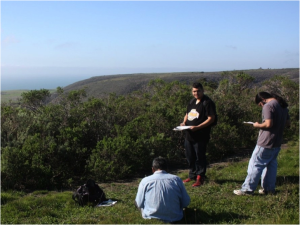
Cruz Vasquez (left) and AMLT Native Stewards Nathan Vasquez (middle) and Abran Lopez (right) record information about ethnobotanical plants at BLM Coast Dairies property.
Photo courtesy Rob Cuthrell
Cultural Resource Management at Coast Dairies:
The Amah Mutsun Land Trust is assisting the Bureau of Land Management (BLM) in the management, protection, interpretation, and education of Native cultural resources and sites at the recently acquired Coast Dairies Property (CDP) on the Central Coast of California. We collaborate with BLM in identifying and managing Native American cultural resources found within CDP, as only a limited amount of cultural resource evaluation has been previously evaluated. The AMLT will develop and implement an integrative historical ecological study of portions of the CDP, identify cultural resources, work with BLM land managers to restore and manage degraded cultural resources, create management plans for Native American cultural resources, protect archaeological sites, and develop interpretive programs and outreach materials to promote community education and engagement.
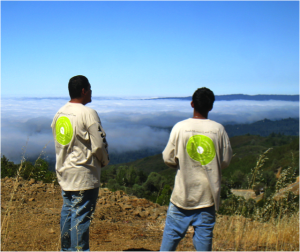
Native Stewards Nathan Vasquez (left) and Gabriel Pineda (right) on the summit of Mt. Humunhum.
Photo courtesy Sara French
Midpeninsula Regional Open Space District
Midpeninsula regional Open Space District (MROSD) manages over 60,000 acres in 26 open space preserves in San Mateo, Santa Cruz, and Santa Clara counties. These lands include Mt. Umunhum—the site of the Amah Mutsun creation story—plus over 150 plant species that are important in the Amah Mutsun ethnobotany. Managers at MROSD work with the AMLT to make sure that these sacred sites and resources are honored, protected, and accessible for Tribal relearning and ceremony. Every year Tribal members and AMLT research associates make trips to MROSD in multiple seasons to locate and monitor culturally significant plant species. MROSD is also consulting with the AMLT on developing public access, interpretation, and a ceremonial space on the Mt. Umunhum summit.

AMLT Native Stewardship Corps conducting an archaeological surveys at Cañada de los Osos.
Photo courtesy Sara French
Cañada de los Osos Ecological Preserve
Cañada de los Osos (CDLO) is an approximately 5,800 acre property owned by the California Department of Fish and Wildlife, located right in the heart of Amah Mutsun territory. The rolling grasslands, oak woodlands, and verdant springs support abundant wildlife and provide an ideal venue for the cultural learning and stewardship activities of the Native Stewardship Corps. The Native Stewardship Corps spent one week working and learning at CDLO in July 2015 and contributed over 250 hours of volunteer labor and ethnobotanical and archaeological research work to CDLO during their stay. The Native Stewardship Corps plans to return to CDLO to continue their stewardship and research at this significant site.
Research Institute of Humanity and Nature
In 2015, the Research Institute of Humanity and Nature in Kyoto, Japan sponsored two episodes of AMLT Native Stewardship Corps fieldwork. The first episode of fieldwork in February lasted three weeks and focused on conservation work, including removal of jubata grass from coastal prairie on a conservation easement at Costanoa lodge. In addition, Native Stewards carried out vegetation surveys in the Santa Cruz Mountains, began building a native garden at Pie Ranch, and learned ethnobotanical information about native plants.
The second episode of fieldwork in October and November lasted two weeks and focused on health and wellness. A cultural leader from the Salt River Tribe lived with the Stewards for one week during this time and conducted daily ceremonies. Together they talked of issues such as the need to respect elders and women, and how to live one’s life by honoring culture. During this episode of the program, Native Stewards gathered traditional foods (such as tanoak acorns) and medicine plants. Native Stewards also tended areas with ethnobotanical resources in Quiroste Valley Cultural Preserve and participated in crafting using traditional plant resources such as tule.
San Vicente Burn Research
In 2015, Sempervirens Fund and Peninsula Open Space Trust invited AMLT to develop a research project to document the effects of low-intensity burning on vegetation following a prescribed burn on a ridgeline of the San Vicente Redwoods property. This prescribed burn— the first on Sempervirens Fund or POST property—is intended to reduce understory fuel loads, creating a defensible fire break along Empire Grade. AMLT has established a number of forest inventory plots that will be used to monitor how the burn effects vegetation in hardwood and conifer-dominated woodland areas. The study will also evaluate the effects of burning on hazelnut, a plant traditionally used for basketry material and food. Although the prescribed burn was scheduled for November, 2015, weather conditions prevented it from being carried out. The burn is now scheduled for fall of 2016.

A selection from the Harrington Notes.
From “The Papers of John P. Harrington in the Smithsonian Institution 1907-1957, Volume Two, Microfilm (digitized, PDF format)”
Harrington Notes Transcription
In partnership with the Amah Mutsun Tribal Band, the Amah Mutsun Land Trust is transcribing 78,000 pages of field notes written by ethnographer John P. Harrington in the 1920s and ‘30s. Containing Mutsun language, ethnobotany, stories, Tribal history, and more, the notes represent a vast collection of conversations with Tribal elders, including culture-bearer Ascension Solorsano. In the 2015 project year alone, Mutsun Tribal members and UC Berkeley students transcribed approximately 9,000 pages of notes into digital format for use and interpretation by the Tribe. The year’s work culminated with the publishing of the first volume of Mutsun Ways, a digital newsletter meant to disseminate information gleaned from the notes to Tribal members.
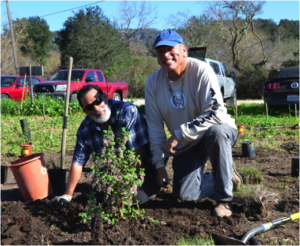
Tribal Elder Michael Higuera (left) and Chairman Valentin Lopez (right) planting at Pie Ranch.
Photo courtesy Sally Kimmel
Mutsun Gardens at Pie Ranch and San Juan Bautista State Historic Park
AMLT is developing two new native plant gardens to give Tribal members a place to steward and harvest traditional plants and to share knowledge about plants with members of the public. The Pie Ranch garden, located on Highway 1 near Año Nuevo, was designed by a Tribal member to be aligned with the four directions, and will have a traditional tule hut in the center. The second garden, located at the San Juan Bautista State Historic Park, will include interpretive materials that will help tell the story of the Amah Mutsun to visitors of the San Juan Bautista Mission. We are grateful to the local nurseries who donated plants for the garden, and the volunteers who have been instrumental in planting the gardens this spring.
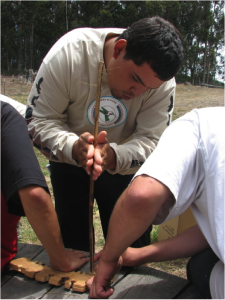
Native Steward Nathan Vasquez starting fire with a traditional elderberry fire drill.
Photo courtesy Rick Flores
The Amah Mutsun Relearning Program at the UC Santa Cruz Arboretum
The Amah Mutsun Relearning Program (AMRP) assists the Amah Mutsun Tribal Band in their efforts to become land stewards once again by helping Tribal members relearn plant identification, ethnobotany, and native plant resource management. Plants of cultural significance are being grown in the California Native Conservation Gardens where Tribal members can come relearn, tend, and gather plant materials for cultural relearning efforts. Educational events, such as the Work & Learn Gatherings, provide experiential learning opportunities for Tribal members, UCSC students, and community members. Additionally, the AMRP uses interpretation, presentations, and events to educate UCSC students and the general public about the importance of traditional ecological knowledge, the history and contemporary issues of the AMTB, ethnobotany, and California Indian lifeways.







